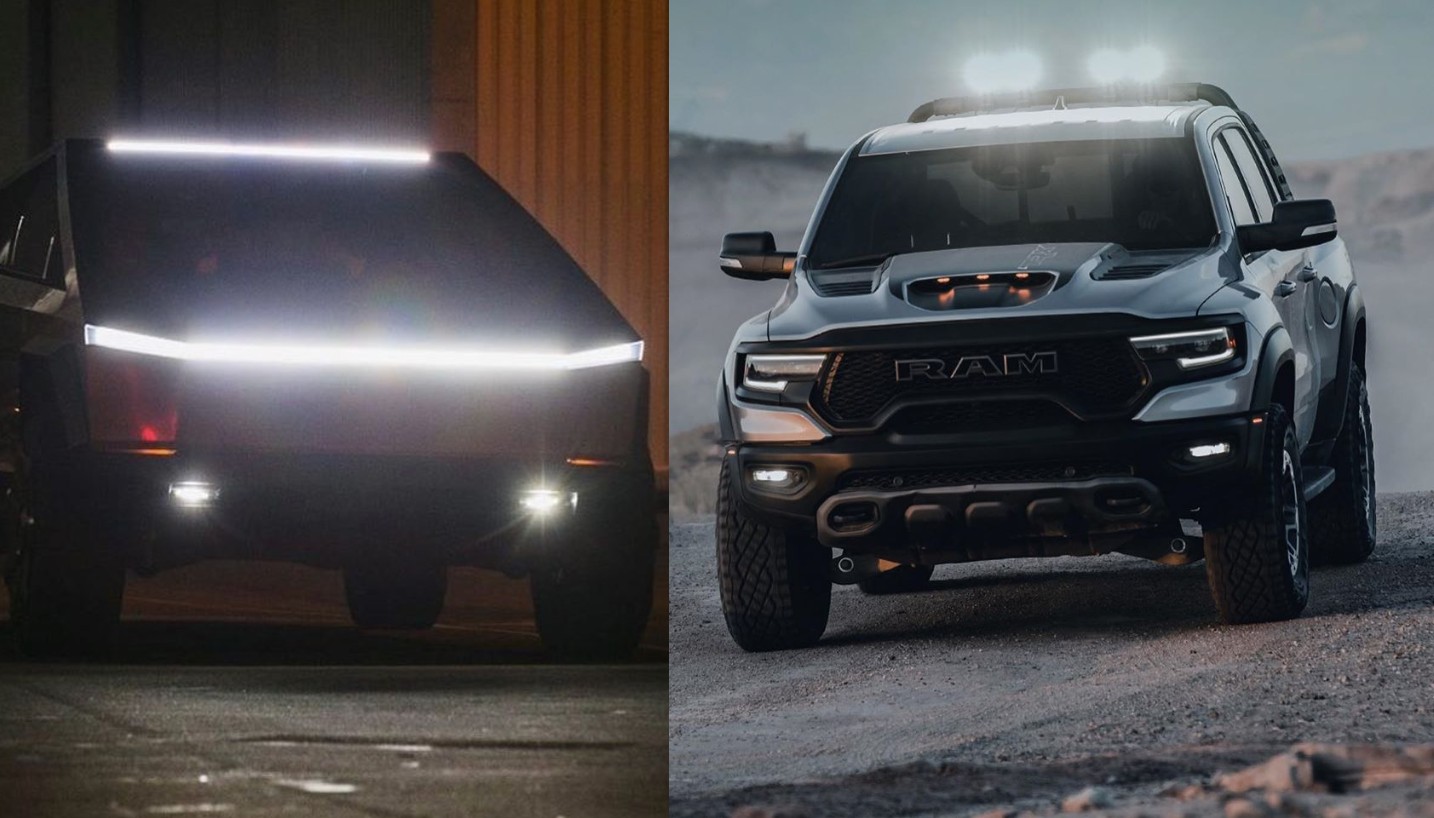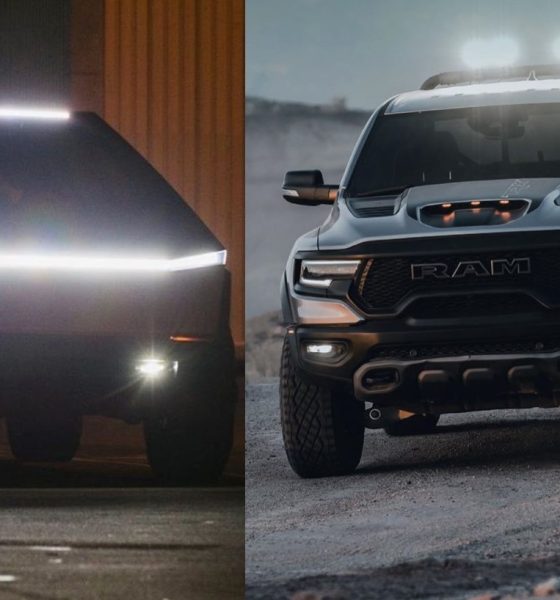

News
Tesla Cybertruck Tri-Motor is surprisingly affordable compared to RAM 1500 TRX
While its design is unapologetically different, the Tesla Cybertruck is built to be a no-compromise alternative to the market’s most compelling pickup trucks. This is part of the reason why Tesla priced the vehicle very reasonably, with the entry-level RWD variant costing less than $40,000 and the top-tier Tri-Motor AWD version starting at less than $70,000. Granted, $70,000 for a pickup truck is not cheap by any means, but it sure is reasonable in comparison to other upcoming trucks from legacy automakers.
Over the years, pickup trucks have transitioned from being pure utility vehicles to luxury, performance machines that are equally capable off-road as they are on paved roads. One such example is Dodge’s RAM trucks. In recent years, RAM Trucks have become more extreme, and this is represented best by the 2021 RAM 1500 TRX, Dodge’s flagship pickup that has over 200 horses more than the Ford F-150 Raptor, thanks to its supercharged 6.2-liter V8 engine that pushes out a whopping 702 hp.
The RAM 1500 TRX has the performance worthy of its flagship status. With its 702 horses, the RAM 1500 TRX is able to accomplish a 0-60 mph time of 4.5 seconds and a quarter-mile time of 12.9 seconds. Top speed is a respectable 118 mph, which is quite noteworthy for a half-ton pickup. But while these specs are definitely impressive, one thing about the RAM 1500 TRX has stood out: its price, which currently stands as the highest in the market.
The RAM 1500 TRX starts at a $71,690 including destination charges, which, interestingly enough, is right on the ballpark of the top-tier Tesla Cybertruck, which starts at $69,900. With Full Self-Driving added, the Cybertruck Tri-Motor AWD could reach a price that’s closer to $80,000. That’s quite still affordable compared to the RAM 1500 TRX, as Dodge’s flagship pickup — when fully loaded with features like radar cruise control, a HUD, and heated leather seats — could hit prices of about $100,000.
A special “Launch Edition” of the RAM 1500 TRX is even available for a price of $92,010 including destination charges. Overall, with its premium price, the RAM 1500 TRX will be the first and only light-duty pickup truck to break the six-figure barrier, at least when the vehicle is expected to go on sale later this year.
This price may very well be challenged by other, upcoming premium trucks coming to market, such as the Rivian R1T, which is created to be a luxurious adventure vehicle with the performance to match. That being said, Rivian has announced earlier this year that the R1T will start under its expected $69,000 price, so it remains to be seen if the top-tier variant of the company’s all-electric pickup would be priced comparably to the RAM 1500 TRX.
As for the Tesla Cybertruck Tri-Motor? The vehicle is looking to be more and more like the bang-for-your-buck pickup when it comes to performance and features. With the $69,900 Cybertruck Tri-Motor AWD, customers could experience a 0-60 mph time of 2.9 seconds and a quarter-mile time of 10.8 seconds, significantly quicker than the flagship RAM.
The Cybertruck also has a maximum payload capacity of 3,500 pounds and a max towing capacity of over 14,000 pounds, far more than the RAM 1500 TRX’s maximum payload of 1,310 pounds and a max towing capacity of 8,100 pounds. This, coupled with a range of over 500 zero-emissions miles per charge, makes the Cybertruck a very compelling alternative to this generation’s best gas-guzzling pickups.

News
Tesla FSD fleet is nearing 7 billion total miles, including 2.5 billion city miles
As can be seen on Tesla’s official FSD webpage, vehicles equipped with the system have now navigated over 6.99 billion miles.

Tesla’s Full Self-Driving (Supervised) fleet is closing in on almost 7 billion total miles driven, as per data posted by the company on its official FSD webpage.
These figures hint at the massive scale of data fueling Tesla’s rapid FSD improvements, which have been quite notable as of late.
FSD mileage milestones
As can be seen on Tesla’s official FSD webpage, vehicles equipped with the system have now navigated over 6.99 billion miles. Tesla owner and avid FSD tester Whole Mars Catalog also shared a screenshot indicating that from the nearly 7 billion miles traveled by the FSD fleet, more than 2.5 billion miles were driven inside cities.
City miles are particularly valuable for complex urban scenarios like unprotected turns, pedestrian interactions, and traffic lights. This is also the difference-maker for FSD, as only complex solutions, such as Waymo’s self-driving taxis, operate similarly on inner-city streets. And even then, incidents such as the San Francisco blackouts have proven challenging for sensor-rich vehicles like Waymos.
Tesla’s data edge
Tesla has a number of advantages in the autonomous vehicle sector, one of which is the size of its fleet and the number of vehicles training FSD on real-world roads. Tesla’s nearly 7 billion FSD miles then allow the company to roll out updates that make its vehicles behave like they are being driven by experienced drivers, even if they are operating on their own.
So notable are Tesla’s improvements to FSD that NVIDIA Director of Robotics Jim Fan, after experiencing FSD v14, noted that the system is the first AI that passes what he described as a “Physical Turing Test.”
“Despite knowing exactly how robot learning works, I still find it magical watching the steering wheel turn by itself. First it feels surreal, next it becomes routine. Then, like the smartphone, taking it away actively hurts. This is how humanity gets rewired and glued to god-like technologies,” Fan wrote in a post on X.
News
Tesla starts showing how FSD will change lives in Europe
Local officials tested the system on narrow country roads and were impressed by FSD’s smooth, human-like driving, with some calling the service a game-changer for everyday life in areas that are far from urban centers.

Tesla has launched Europe’s first public shuttle service using Full Self-Driving (Supervised) in the rural Eifelkreis Bitburg-Prüm region of Germany, demonstrating how the technology can restore independence and mobility for people who struggle with limited transport options.
Local officials tested the system on narrow country roads and were impressed by FSD’s smooth, human-like driving, with some calling the service a game-changer for everyday life in areas that are far from urban centers.
Officials see real impact on rural residents
Arzfeld Mayor Johannes Kuhl and District Administrator Andreas Kruppert personally tested the Tesla shuttle service. This allowed them to see just how well FSD navigated winding lanes and rural roads confidently. Kruppert said, “Autonomous driving sounds like science fiction to many, but we simply see here that it works totally well in rural regions too.” Kuhl, for his part, also noted that FSD “feels like a very experienced driver.”
The pilot complements the area’s “Citizen Bus” program, which provides on-demand rides for elderly residents who can no longer drive themselves. Tesla Europe shared a video of a demonstration of the service, highlighting how FSD gives people their freedom back, even in places where public transport is not as prevalent.
What the Ministry for Economic Affairs and Transport says
Rhineland-Palatinate’s Minister Daniela Schmitt supported the project, praising the collaboration that made this “first of its kind in Europe” possible. As per the ministry, the rural rollout for the service shows FSD’s potential beyond major cities, and it delivers tangible benefits like grocery runs, doctor visits, and social connections for isolated residents.
“Reliable and flexible mobility is especially vital in rural areas. With the launch of a shuttle service using self-driving vehicles (FSD supervised) by Tesla in the Eifelkreis Bitburg-Prüm, an innovative pilot project is now getting underway that complements local community bus services. It is the first project of its kind in Europe.
“The result is a real gain for rural mobility: greater accessibility, more flexibility and tangible benefits for everyday life. A strong signal for innovation, cooperation and future-oriented mobility beyond urban centers,” the ministry wrote in a LinkedIn post.
News
Tesla China quietly posts Robotaxi-related job listing
Tesla China is currently seeking a Low Voltage Electrical Engineer to work on circuit board design for the company’s autonomous vehicles.

Tesla has posted a new job listing in Shanghai explicitly tied to its Robotaxi program, fueling speculation that the company is preparing to launch its dedicated autonomous ride-hailing service in China.
As noted in the listing, Tesla China is currently seeking a Low Voltage Electrical Engineer to work on circuit board design for the company’s autonomous vehicles.
Robotaxi-specific role
The listing, which was shared on social media platform X by industry watcher @tslaming, suggested that Tesla China is looking to fill the role urgently. The job listing itself specifically mentions that the person hired for the role will be working on the Low Voltage Hardware team, which would design the circuit boards that would serve as the nervous system of the Robotaxi.
Key tasks for the role, as indicated in the job listing, include collaboration with PCB layout, firmware, mechanical, program management, and validation teams, among other responsibilities. The role is based in Shanghai.
China Robotaxi launch
China represents a massive potential market for robotaxis, with its dense urban centers and supportive policies in select cities. Tesla has limited permission to roll out FSD in the country, though despite this, its vehicles have been hailed as among the best in the market when it comes to autonomous features. So far, at least, it appears that China supports Tesla’s FSD and Robotaxi rollout.
This was hinted at in November, when Tesla brought the Cybercab to the 8th China International Import Expo (CIIE) in Shanghai, marking the first time that the autonomous two-seater was brought to the Asia-Pacific region. The vehicle, despite not having a release date in China, received a significant amount of interest among the event’s attendees.








